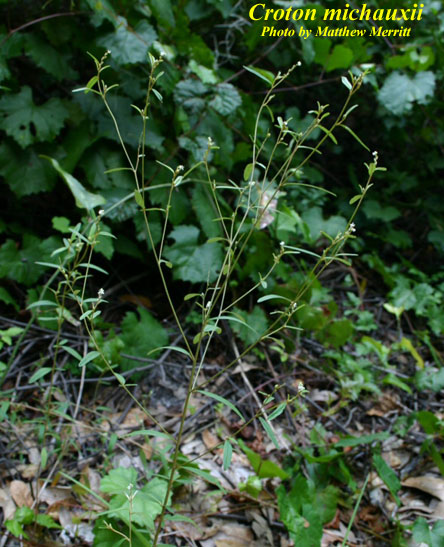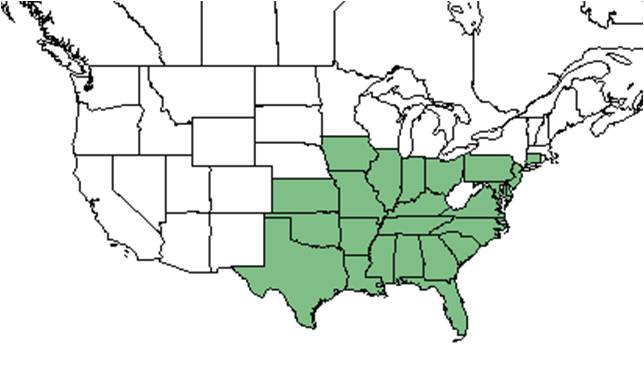Difference between revisions of "Croton michauxii"
Emmazeitler (talk | contribs) (→Taxonomic notes) |
|||
| Line 51: | Line 51: | ||
<!--===Diseases and parasites===--> | <!--===Diseases and parasites===--> | ||
| − | ==Conservation and | + | ==Conservation, cultivation, and restoration== |
| − | == | + | ==Cultural use== |
==Photo Gallery== | ==Photo Gallery== | ||
Revision as of 13:46, 8 June 2021
| Croton michauxii | |
|---|---|

| |
| Photo by Matthew Merritt, Atlas of Florida Vascular Plants | |
| Scientific classification | |
| Kingdom: | Plantae |
| Division: | Magnoliophyta - Flowering plants |
| Class: | Magnoliopsida - Dicotyledons |
| Order: | Euphorbiales |
| Family: | Euphorbiaceae |
| Genus: | Croton |
| Species: | C. michauxii |
| Binomial name | |
| Croton michauxii G.L. Webster | |

| |
| Natural range of Croton michauxii from USDA NRCS Plants Database. | |
Common names: Michaux's croton; sand rushfoil; narrowleaf rushfoil
Contents
Taxonomic notes
Synonyms: Crotonopsis linearis Michaux; Croton michauxii G.L. Webster var. michauxii.[1]
Varieties: none.[1]
Description
The leaves of C. michauxii are arranged opposite, the green and white flowers are arranged on a spike. [2]
Distribution
Ecology
Habitat
In the Coastal Plain in Florida, C. michauxii can be found at lake margins; mesic woodlands; pine flatwoods; longleaf pine-turkey oak sandhills; open oak scrubs; upland pine/oak forests; and cypress ponds. It can be found in human disturbed areas such as open firelanes, roadsides, clear cut sand ridges, old fields, pastures, bulldozed oak scrubs, clobbered slash pine forests, and pine plantations. [3] Soil types include sand and loamy sand. [3] Associated species include Quercus virginiana, Q. laevis, Q. incana, Q. myrtifolia, Q. chapmanii, Serenoa repens, Paronychia patula, Paronychia baldwinii and Chrysopsis subulata. [3]
Phenology
C. michauxii has been observed to flower and fruit from June through October with peak inflorescence in July.[4] [3]
Pollination
The following Hymenoptera families and species were observed visiting flowers of Croton michauxii at Archbold Biological Station: [5]
Halictidae: Lasioglossum coreopsis, L. lepidii, L. nymphalis, L. placidensis
Sphecidae: Cerceris blakei, C. tolteca, Philanthus ventilabris, Tachysphex similis
Vespidae: Microdynerus monolobus, Parancistrocerus salcularis rufulus, Stenodynerus fundatiformis, S. histrionalis rufustus, S. lineatifrons
Conservation, cultivation, and restoration
Cultural use
Photo Gallery
References and notes
- ↑ 1.0 1.1 Weakley, A.S. 2015. Flora of the southern and mid-atlantic states. Working Draft of 21 May 2015. University of North Carolina at Chapel Hill, Chapel Hill, North Carolina.
- ↑ [Southeastern Flora] Accessed: December 7, 2015
- ↑ 3.0 3.1 3.2 3.3 Florida State University Robert K. Godfrey Herbarium database. URL: http://herbarium.bio.fsu.edu. Last accessed: July 2015. Collectors: Loran C. Anderson, George R. Cooley, R.J. Eaton, R.K. Godfrey, R.D. Houk, C. Jackson, Lisa Keppner, R. Kral, Robert L. Lazor, S.W. Leonard, Richard S. Mitchell, John Morrill, Leon Neel, R.A. Norris, R.E. Perdue Jr., Gwynn W. Ramsey, James D. Ray Jr., A.G. Shuey, J. Sincock, Cecil R. Slaughter, Wakulla, D.B. Ward, A.A. Will. States and Counties: Florida: Citrus, DeSoto, Dixie, Flagler, Franklin, Gadsden, Gilchrist, Hamilton, Hernando, Lake, Leon, Levy, Liberty, Putnam, Nassau, Seminole, Suwannee, Taylor, Wakulla, Washington. Compiled by Tall Timbers Research Station and Land Conservancy.
- ↑ Nelson, G. PanFlora: Plant data for the eastern United States with emphasis on the Southeastern Coastal Plains, Florida, and the Florida Panhandle. www.gilnelson.com/PanFlora/ Accessed: 8 DEC 2016
- ↑ Deyrup, M.A. and N.D. 2015. Database of observations of Hymenoptera visitations to flowers of plants on Archbold Biological Station, Florida, USA.